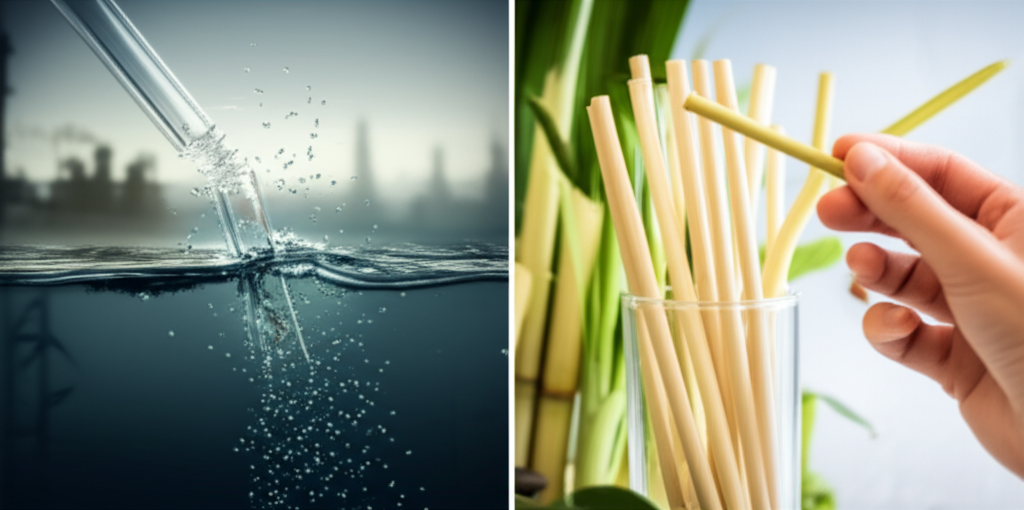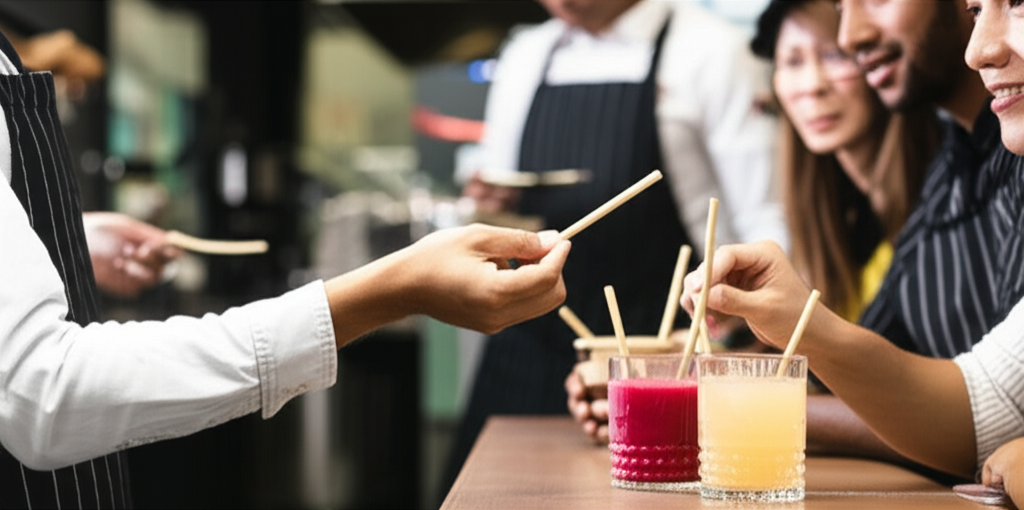The plastic straw dilemma: a highly visible symbol of environmental impact and a growing regulatory headache for restaurants. With consumer demand for eco-friendly options surging (80% prefer them, and many are willing to pay more) and legislative pressure mounting (US state/city bans, EU SUPD), the imperative for change is undeniable. Biodegradable straws offer a viable, high-performing solution for modern eateries. This guide will equip restaurant decision-makers with the knowledge to confidently choose the right biodegradable straws, ensuring compliance, enhancing brand image, and satisfying eco-conscious diners.
The Journey to Sustainable Sipping: A Brief History of Straws and the Green Revolution
From ancient origins to modern convenience: The earliest straws, such as Sumerian gold tubes and natural wheat stalks, date back to around 3000 BCE. Marvin C. Stone’s invention of the paper straw in 1888 and Joseph B. Friedman’s creation of the bendable straw in 1937 marked significant advancements. However, the rise of cheap, disposable plastic straws in the 1950s and 60s replaced paper, setting the stage for an environmental crisis.
The environmental awakening arrived with a growing awareness of plastic pollution—over 500 million straws are used daily in the US, contributing significantly to ocean debris. Escalating plastic bans globally (Seattle 2018, Taiwan 2020, EU 2021) further fueled the demand for alternatives. This need for eco-friendly options sparked new material science and innovation in biodegradable materials.

Understanding Your Options: A Deep Dive into PLA-Free Biodegradable Straws
The core promise of PLA-Free is a 100% plant-based composition, without polylactic acid (PLA), which often requires industrial composting. The key benefits for restaurants include a reduced environmental footprint, the absence of harmful microplastics, and a BPA/PFAS/chemical-free guarantee for consumer safety.
Sugarcane Straws: The Upcycled Agricultural Champion
The manufacturing process leverages bagasse, the fibrous sugarcane residue, transforming it into pulp, which is then molded and heat-treated in a zero-waste process. Key performance properties include impressive durability, water resistance lasting 4-24 hours without sogginess, and heat resistance up to 90-100°C, making them suitable for hot beverages. Sugarcane straws offer a neutral taste, a smooth feel, and don’t transfer any flavors. These straws are non-toxic, gluten-free, and free from harmful chemicals.
Environmentally, they are 100% biodegradable and home compostable, decomposing in weeks to months in home compost or 90-180 days in industrial facilities, returning to nature as water, CO2, and biomass. Their market adoption in US foodservice is growing in coffee shops, restaurants, bars, and hotels due to their excellent performance and eco-friendly credentials, with bulk availability and comparable cost to other premium alternatives.
PHA Straws: The Next-Generation Bioplastic Marvel
The manufacturing process involves the microbial fermentation of organic materials such as canola oil and sugars to produce a biopolymer. PHA straws mimic traditional plastic straws, offering a familiar user experience. These straws are robust, maintain their structure in hot and cold drinks up to 100°C, and some even come with a “Never Soggy Promise.” They are versatile and suitable for various drink types, including cocktails, smoothies, and jumbo drinks, are FDA-approved, and BPA/PFAS-free.
Their true biodegradability spans diverse environments, including industrial compost, home compost, soil (12 months), and marine environments (4-8 months, 90% disintegration in 6 months at 30°C), decomposing into CO2, water, and biomass. Major chains like Dunkin’, Starbucks (pilots), TOUS les JOURS, and Sweetgreen are adopting PHA straws, with significant market growth projected (e.g., 15-20% CAGR 2025-2033).Learn more about our commitment to sustainable materials at momoio.com.

Beyond Sugarcane and PHA: Other Emerging PLA-Free Alternatives
Advanced Paper Straws feature innovations addressing sogginess with improved coatings and natural adhesives. Bacterial cellulose straws are stronger than paper, cost-comparable to plastic, and break down without industrial composting. Edible straws made from wheat, rice, and cornstarch offer a zero-waste, dual benefit. Other materials being explored include rice, grass, bamboo, wheat, cornstarch, seaweed, and agave.
Navigating the Nuances: Addressing Challenges and Criticisms for Restaurants
The composting conundrum involves the limited industrial composting infrastructure in the US. With only ~200 facilities, and only ~15% accepting packaging, many biodegradable straws still end up in landfills. To address this, understand your local infrastructure, prioritize certified home-compostable options where industrial composting isn’t viable, or explore reusable programs.
The cost vs. value equation reveals a higher initial cost compared to conventional plastic straws, but consider long-term savings from durability (less replacement needed), reduced waste management fees, and enhanced brand image/customer loyalty. Bulk purchasing reduces per-straw cost (e.g., $0.05 for sugarcane). Performance expectations must also be addressed. Past negative experiences with soggy paper straws create skepticism, which can be overcome by highlighting the superior performance of sugarcane and PHA, such as durability, heat resistance, and neutral taste, emphasizing consistent customer experience.Explore our range of sustainable packaging solutions at momoio.com.
Address greenwashing concerns and prioritize transparency by managing misleading “plant-based” or “biodegradable” claims (e.g., PLA requiring specific conditions, PFAS in some alternatives). Demand certifications (OK Home Compost, BPI, ASTM D6400, EN13432), ensure PFAS-free products, and transparently communicate disposal methods to customers.Discover our certification standards for sustainable products at momoio.com.
Navigate the complex regulatory landscape of the patchwork of US state/city regulations and the EU’s strict SUPD (PHA classified as “plastic”) by partnering with knowledgeable suppliers, staying informed on local and national mandates, and aligning with global best practices to future-proof your business. The Biodegradable Products Institute (https://bpiworld.org/) provides certification for compostable products.
Comparative Analysis: Choosing the Right Biodegradable Straw for Your Restaurant
Strategic selection is critical; there is no one-size-fits-all solution. Key comparison points include:
| Feature / Material | Sukkerrørssugerør | PHA sugerør | Traditional Plastic Straws | Paper Straws (for contrast) |
|---|---|---|---|---|
| Raw Material | Sugarcane Bagasse (waste) | Fermented Plant Oils/Sugars | Petroleum-based | Wood Pulp/Paper |
| Biodegradability | Home & Industrial Compostable, Marine (slow) | Home, Industrial, Soil, Marine (fastest bio-plastic) | Centuries, Microplastics | Compostable (2-6 weeks), but often soggy |
| Feel/Performance | Sturdy, smooth, natural look | Plastic-like, durable | Familiar, durable | Can get soggy, papery taste |
| Heat Resistance | High (up to 90-100°C) | Very High (up to 100°C) | Very High | Low (soggy in hot liquids) |
| Cost (Relative) | Medium | High (decreasing with scale) | Low | Medium |
| PFAS/Chemicals | Free from BPA, PFAS, etc. | Free from BPA, PFAS, etc. | Contains BPA, microplastics | Can contain PFAS |
| Composting Req. | Industrial preferred, Home certified | Industrial/Home, Marine degradable | None (landfill/litter) | Industrial/Home |
| Reusability | Primarily single-use, some multiple washes | Single-use | Single-use | Single-use |
To tailor your choice, High-Volume QSRs should prioritize cost-effectiveness and performance. Fine Dining establishments can focus on a premium feel and a strong sustainability message. Cafes/Bars should consider heat resistance and durability for various beverages. The European Bioplastics association (https://www.european-bioplastics.org/) offers information on bioplastics and their environmental impact.
Beyond compliance, choosing the right biodegradable straw demonstrates a genuine commitment to sustainability, attracts eco-conscious customers, and strengthens brand reputation.

The Future of Sustainable Straws: Innovations on the Horizon
Researchers are continuously developing new materials and manufacturing processes. Faster degrading bioplastics, such as foamed cellulose diacetate (CDA), show 50% degradation in 16 weeks in marine environments. Novel materials like bacterial cellulose and seashell minerals offer enhanced strength and faster breakdown. Advanced manufacturing techniques, including high-speed machinery, biodegradable coatings, natural adhesives, and plant-based inks, improve performance and efficiency.
The global eco-friendly straw market is projected to reach nearly $25.1 billion by 2035 (7.3% CAGR), with North America in the lead due to high demand. This shift to biodegradable straws is part of a larger movement towards sustainable packaging, reducing waste, and creating new opportunities in agricultural and manufacturing sectors. The Sustainable Packaging Coalition (https://sustainablepackaging.org/) provides resources and guidance on sustainable packaging solutions.
Making the Sustainable Switch for a Greener Tomorrow
Biodegradable straws, especially PLA-free sugarcane and PHA options, offer a compelling answer to the plastic crisis, balancing performance with planetary well-being. Evaluate your restaurant’s specific needs, budget, and local composting infrastructure. Engage with certified suppliers to explore PLA-free sugarcane and PHA straw options. Educate your staff and customers on your sustainable choices and proper disposal. By making an informed switch, your restaurant not only complies with evolving regulations but also leads the way in environmental responsibility, attracting and retaining a growing segment of sustainability-minded consumers. Join the movement towards a cleaner, greener dining experience.






